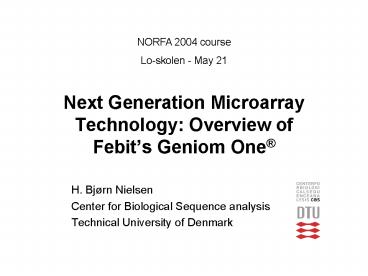Next Generation Microarray Technology: Overview of Febits Geniom One - PowerPoint PPT Presentation
1 / 21
Title:
Next Generation Microarray Technology: Overview of Febits Geniom One
Description:
Stanford microarrays: Are flexible, but new probes must be ... Castle et al., Genome Biol. 2003; 4 (10): R66. Genome studies, Bioinformatics, Methods, Genetics ... – PowerPoint PPT presentation
Number of Views:101
Avg rating:3.0/5.0
Title: Next Generation Microarray Technology: Overview of Febits Geniom One
1
Next Generation Microarray Technology Overview
of Febits Geniom One
NORFA 2004 course Lo-skolen - May 21
- H. Bjørn Nielsen
- Center for Biological Sequence analysis
- Technical University of Denmark
2
Microarrays - The Technologies
Stanford microarraysAffymetrixFebit
3
FEBIT
Design Probes Import into Geniom One
Over Night Synthesis
4
The Technologies - Costs
Facility setup cost Stanford microarrays lt 1
mill kr Affymetrix lt 2 mill kr Febit lt 2.5
mill kr
Cost pr. transcript Stanford microarrays lt 0.5
kr Affymetrix lt 0.5 kr Febit lt 2.5 kr
5
The Technologies - Flexibility
Stanford microarrays Are flexible, but new
probes must be ordered each timeAffymetrix
arrays Are not flexible Febit arrays Are
highly flexible, the probes are synthesized over
night inside Geniom One from an imported
template file
6
The Technologies - Data Quality
- Reproducibility of data
- - the pearson correlation
- Stanford microarrays 0.80-0.95
- Affymetrix gt 0.95
- Febit gt 0.95
7
The Technologies - Choice of
- Stanford microarrays If you work with a limited
number of species - maybe not yet sequenced -
inexpensive - variable data quality
- Affymetrix If you work with standard species
- expensive - high quality of data
- Febit If you work with many different species
with available sequence information and/or wishes
to perform iterative experiments - expensive -
high quality of data
8
The Geniom One Processor
- 8 arrays with 6,776 probes
- gt54,000 probes pr. processor
9
Photolithography - Micromirrors
10
Photolithography
in situ synthesis
Spacers bound to surface with photolabile
protection groups
11
Output from Geniom one
12
A Febit experiment - Goal and Idea
Find all Transcription Start Sites (TSSs) in B.
subtilis - We do this by the use of the Geniom
One - A two-step method
- Dichotomy- Pin-point
13
1. The Dichotomy Method
14
The Problem of Tiling
1
15
Probe-Intensity Profiles for Intron-Exon
Boundaries
Tiling of 35 mers
16
We Need Increased Specificity
We know from physical chemistry that DNADNA and
RNADNA hybridizations are destabilized by
mismatches or gaps, and that this is less
pronounced for distal positions.
Contribution to stability
Surface end Middle
Solution end
Position
17
2. The Pin-point Method
1
18
3. The Pin-point Method
1
...........TTCAATATAGGAGGATCATATGCCAG........
Probes
19
The Hole Expressome?
- What RNA should we use?- Analyzed existing
microarray data- Found that most genes were
represented in - Heat shock experiment - 4
different time points in minimal medium
20
Transcription
- What will we see?- How pronounced are the
holes between the genes
?
?
?
?
?
?
21
Labeling of the RNA
- Two types of labeling - 5 label after
fragmentation - 5 label before
fragmentation
22
Acknowledgements
Hanne Ø. JarmerHanni Willenbrock Steen
KnudsenHans Henrik SaxildKristine Bøje Dahlin































